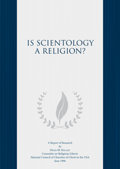Thus far the jurisprudence of the United States has survived for over 200 years without an official definition of religion, and it is to be hoped that no court or governmental agency ever feels obliged to compose one, since it would tend to force all newly emerging religions to conform to its Procrustean bed. Still, if “religion” is to be a preferred category of the civil law, as it was—fortunately and wisely—conceived to be by the authors of the First Amendment of the Constitution, that term will have to be applied by the civil magistrate to include or exclude the claimants of its benefits—modest though they be.
The term “religion” did not need to be defined in the First Amendment, since everyone knew in general to what it referred. Even today there is little perplexity about what “religion” is in 95 percent of cases. It is the boundary questions pertaining to new and unconventional religions or groups claiming to be such that cause the perplexities. In these instances, the civil magistrate can refer to resemblances to bodies already acknowledged to be religious, but we have seen above how difficult a task that can be. And how close must the resemblance be? What elements of similarity are essential and which are optional? And upon what evidence from what sources should the magistrate rely to make a determination?
The Supreme Court has wisely concluded that the magistrate may not assess the truth or falsity of the claimant’s beliefs (U.S. v. Ballard, 322 U.S. 78 (1944)), nor whether they are theistic (Torcaso, Seeger and Welsh, citations supra), nor indeed inquire into the content of doctrines and tenets at all (Presbyterian Church v. Mary Elizabeth Blue Hull Memorial Presbyterian Church, 393 U.S. 440 (1969)). Perhaps a slightly more penetrating scrutiny may be undertaken at the threshold, before a group is recognized as a religion, but even here the magistrate is limited in the depth to which he or she can penetrate (cf. Ballard). The court may not specify what content or what structure a group must exhibit to be deemed “religious,” nor, within certain broad limits, what conduct will disqualify a group. (The Mormon cases, in which the Corporation of the Church of Latter-day Saints was dissolved because it taught and practiced polygamy (1890), reached results which the courts would probably not reach today, but even those drastic measures did not contend that Mormonism was not a religion, only that its teaching of plural marriage could be prohibited.)2
What the courts can do—and have done in Seeger and Welsh—is to examine the function of religion to see if it “occupies in the life of its possessor a place parallel to that filled by the God of those admittedly qualifying for the exemption” (Seeger v. U.S., 30 U.S. 163). To do this, they should rely on evidence provided, not by outsiders or defectors, but by the only competent witnesses in a position to know whether they are indeed gaining the consolations of religion from the organization in question: the current consumers thereof, the present adherents of the group claiming to be a religion.
How shall the court know whether what they are gaining from the organization are indeed the consolations of religion? There is a considerable literature devoted to defining or describing what it is that religion provides for human beings and human societies, ranging from Durkheim (Elementary Forms of the Religious Life) to Weber (Sociology of Religion). Unfortunately, the scholarly writers on the subject of the function of religion do not agree among themselves what that function is. But their differing views can be subsumed under a broader rubric: Religion is that form of human activity which provides an explanation of the ultimate meaning of life to its adherents. (This description is explained in greater detail in the author’s previous works, Why Conservative Churches Are Growing, Harper & Row, 1972, 1977, pp. 37–41, and Why Churches Should Not Pay Taxes, Harper & Row, 197, pp. 59–69.)
There are several subsidiary facets in this description that should not be overlooked.
a. It assumes that a group claims to be a religion. Scientology has certainly made that claim.
b. An organization claiming to be a religion must have a body of adherents of sufficient continuity to be identifiable over time and of sufficient numbers to support it by their voluntary contributions. Scientology certainly has such a body of adherents.
c. The organization claiming to be a religion must offer some explanation of the ultimate meaning of life such as satisfies the needs of its adherents. That is the crucial question that necessitated the interviews with a cross-section of consumers of the would-be religion of Scientology. What is the upshot of that inquiry?
2. The Act of Congress of 1887 disincorporating the Mormon Church and forfeiting its property to the United States contained a proviso “that no building…which is held and occupied exclusively for the purposes of worship of God…shall be forfeited.” Late Corporation of the Church of Jesus Christ of Latter-Day Saints v. U.S., 136 U.S. 1, 7 (1890).





























